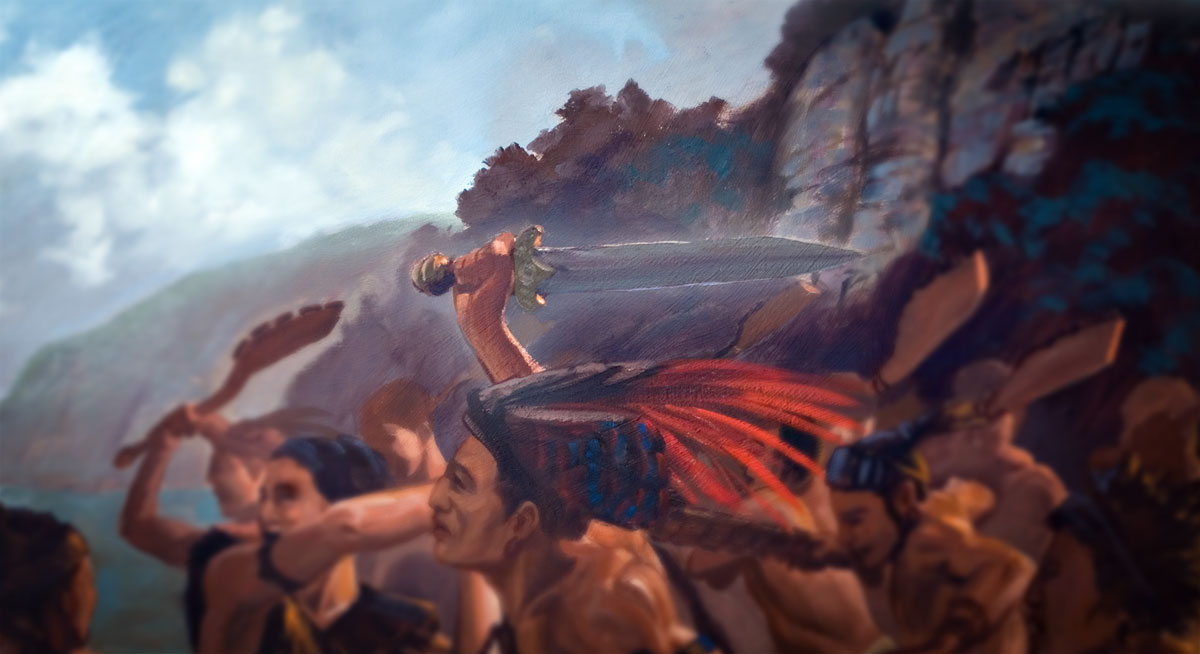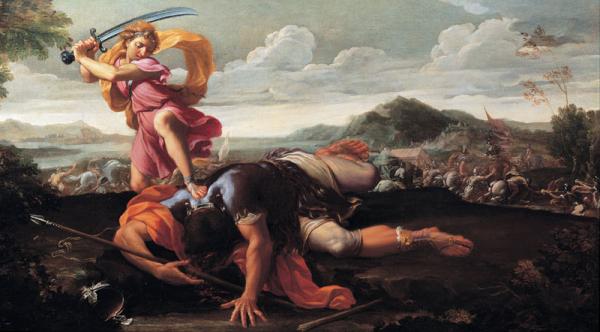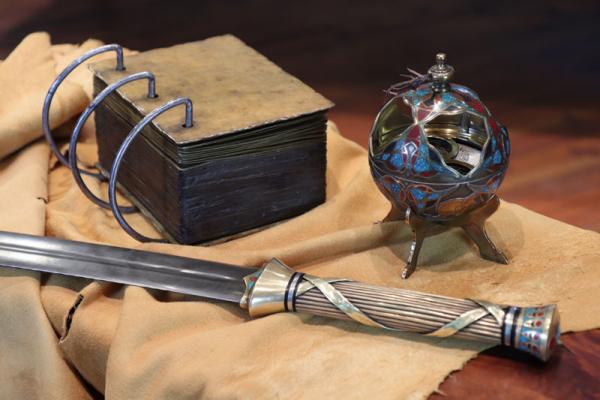You are here
Why Was the Sword of Laban So Important to Nephite Leaders?

Words of Mormon 1:13
The Know
From the time that Nephi drew Laban’s sword from its sheath and slew him with it,1 the weapon held special significance for the Nephite nation. The Book of Mormon references the sword of Laban on multiple occasions. For instance, Nephi said that in order to protect his people he “did take the sword of Laban, and after the manner of it did make many swords” (2 Nephi 5:14). Jacob noted that Nephi “wielded the sword of Laban in their defence” (Jacob 1:10). Mormon mentioned that King Benjamin “did fight with the strength of his own arm, with the sword of Laban” (Words of Mormon 1:13). And in Mosiah 1:16, we learn that Mosiah received the sword of Laban from King Benjamin.
In light of these passages, some may rightfully wonder what was so special about Laban’s sword.2 In the ancient world—including ancient Israel—swords were often seen as a symbol of authority, kingship, or divine favor.3 It seems that this is precisely the symbolism that Nephi intended when he described the circumstances under which he obtained Laban’s sword.
Several studies have shown that Nephi intentionally connected his slaying of Laban with David’s slaying of Goliath, and that in both cases, the event signified the young hero’s foreordained kingship (see appendix).4 Also, in each story, the sword itself became a national heir loom, as well as an enduring symbol of divine deliverance and royal legitimacy.5 Brett Holbrook has noted six points of similarity between the sword of Laban and the sword of Goliath:
- Each sword was originally wielded by a man of might.
- Each sword’s owner had his head cut off with his own sword by a faithful youth.
- Each sword was finely crafted for its time and was unique.
- Each sword was revered by the people.
- Each sword was used to lead people.
- Each sword was a symbol of authority and kingship.6
It could be added that both swords were included in their respective nations’ national treasuries.7 The sword of Goliath was kept with the high priestly ephod which was associated with the Urim and Thummim (1 Samuel 21:9). Among the Nephites, the sword of Laban was preserved with the plates of brass, the interpreters, the breastplate, the Liahona, and the Book of Mormon itself (Mosiah 1:16; Doctrine and Covenants 17:1).8
Noel B. Reynolds has argued that “Nephi carefully constructed what he wrote to convince his own and later generations that the Lord had selected him over his older brothers to be Lehi’s successor. Thus, one interesting way to read the account is as a political tract produced to show that his rule was authoritative.”9 The way that Nephite kings revered the sword of Laban significantly supports Reynolds’ thesis. In Nephi’s narrative, the sword of Laban played a key role in foreshadowing his future kingship and legitimizing his divine calling as a “ruler and a teacher over [his] brethren” (1 Nephi 2:22).10 The story of his obtaining the sword is loaded with political significance, as well as spiritual symbolism.
The Why
Understanding why the Nephites revered the sword of Laban also sheds light on why it was included among the Nephite relics shown to the Three Witnesses by the angel Moroni.11 In his dying testimony, Martin Harris declared, “Just as sure as you see the sun shining, just as sure am I that I stood in the presence of an angel of God with Joseph Smith, and saw him hold the gold plates in his hands. I also saw the Urim and Thummim, the breastplate, and the sword of Laban.”12 David Whitmer said that a “glorious personage appeared unto them and exhibited to them the plates, the sword of Laban, the Directors which were given to Lehi (called Liahona), the Urim and Thummim, and other records.”13
The sword of Laban symbolized the hand of God in the founding of the Nephite nation and in delivering them from their enemies. In our day, it similarly helps legitimize Joseph Smith’s calling as a prophet and demonstrates God’s hand in the Restoration. Its physical reality—as testified of by the Three Witnesses—supports the historical reality of the Nephite prophets who wrote the Book of Mormon as well as Joseph Smith’s claims about its divine translation.
The sword also symbolizes the importance of good leaders. Nephi said he “did take the sword of Laban, and after the manner of it did make many swords” (2 Nephi 5:14). And Jacob, right after mentioning Nephi’s use of Laban’s sword, said that “whoso should reign in his stead were called by the people, second Nephi, third Nephi, and so forth, according to the reigns of the kings” (Jacob 1:11). Just as the sword of Laban was a template for other swords, Nephi was a template for righteous Kings. Both Nephi’s name and his sword became inseparably connected to the early Nephite monarchy, each serving as high-quality models for others to follow.
Perhaps most importantly, the sword of Laban can help us remember to follow the commandments of the Lord and the whisperings of the Spirit (1 Nephi 4:6). Nephi conquered his enemy and foreshadowed his kingly status by confidently placing his trust in the Lord and diligently following His commandments, even when others wanted to give up and return empty handed (1 Nephi 3:14). Likewise, the sword of Laban is an enduring symbol of God’s willingness to “prepare a way” for each of us to “go and do the things which the Lord hath commanded” (v. 7).
Further Reading
Ben McGuire, “Nephi and Goliath: A Case Study of Literary Allusion in the Book of Mormon,” Journal of the Book of Mormon and Other Restoration Scripture 18, no. 1 (2009): 16–31.
Alan Goff, “How Should We Then Read? Reading Mormon Scripture after the Fall,” FARMS Review 21, no. 1 (2009): 137–178.
Val Larsen, “Killing Laban: The Birth of Sovereignty in the Nephite Constitutional Order,” Journal of Book of Mormon Studies 16, no. 1 (2007): 26–41, 84–85.
Brett L. Holbrook, “The Sword of Laban as a Symbol of Divine Authority and Kingship,” Journal of Book of Mormon Studies 2, no. 1 (1993): 39–72.
Appendix14
|
Nephi and Laban |
David and Goliath |
|---|---|
|
Nephi was chosen by God as a ruler before his conflict with Laban (1 Nephi 2:1; 3:29). |
David was anointed as a king of Israel before his conflict with Goliath (1 Samuel 16:3). |
|
Nephi was “exceedingly young” when he slew Laban (1 Nephi 2:16). |
David was “but a youth” when he slew Goliath (1 Samuel 1:33). |
|
Despite his youth, Nephi was “a man large in stature” and received “much strength of the Lord” (1 Nephi 2:16; 4:31). |
Despite his youth, David was “a mighty valiant man” (1 Samuel 16), who had killed a lion and a bear (1 Samuel 17:34–37). |
|
Nephi was sent by his father to obtain the plates of brass, which led to his confrontation with Laban (1 Nephi 3:3–4). |
David was sent to the battlefront by his father, which led to his confrontation with Goliath (1 Samuel 17:17–18). |
|
Nephi obeyed the commands of his father: “And it came to pass that I, Nephi, said unto my father: I will go and do the things which the Lord hath commanded” (1 Nephi 3:7). |
David obeyed the commands of his father: “And David rose up early in the morning, and left the sheep with a keeper, and took, and went, as Jesse had commanded him” (1 Samuel 17:17, 20). |
|
Nephi received a blessing of divine favor from his father: “Therefore go, my son, and thou shalt be favored of the Lord, because thou hast not murmured” (1 Nephi 3:6). |
David received a blessing that God would be with him from Saul: “And Saul said unto David, Go, and the Lord be with thee” (1 Samuel 17:37). |
|
Nephi declared, “Let us be faithful” (1 Nephi 3:16; 4:1) and “Let us be strong” (1 Nephi 4:2). |
David declared to Saul, “Let no man’s heart fail because of [Goliath] (1 Samuel 17:31). |
|
Nephi declared to his father that he would “go and do the things which the Lord hath commanded” (1 Nephi 3:7; emphasis added). |
David declared to Saul, that he would “go and fight with this Philistine” (1 Samuel 17:31; emphasis added). |
|
Laman said to Nephi, “How is it possible that the Lord will deliver Laban into our hands? Behold, he is a mighty man, and he can command fifty, yea, even he can slay fifty; then why not us?” (1 Nephi 3:31). |
Saul said to David, “Thou art not able to go against this Philistine to fight with him: for thou art but a youth, and he a man of war from his youth” (1 Samuel 17:33) |
|
In response to his brothers’ doubts, Nephi cited two miracles related to the parting of the Red Sea—the deliverance of the Israelites and the destruction of the Egyptian army (1 Nephi 4:2). The Israelites were saved and the Egyptians were killed. |
In response to the Saul’s doubts, David reported two times when he was tending sheep and was miraculously delivered by the Lord—once from a lion and once from a bear (1 Samuel 17:34–37). The sheep were saved and the predators were killed. |
|
Nephi then applied the two miraculous deliverances he had just cited to their own situation: “Let us go up; the Lord is able to deliver us, even as our fathers, and to destroy Laban, even as the Egyptians” (1 Nephi 4:3). |
David then applied the two miraculous deliverances he had just cited to his current situation: “The Lord that delivered me out of the paw of the lion, and out of the paw of the bear, he will deliver me out of the hand of this Philistine” (1 Samuel 17:37). |
|
Nephi’s older brothers (and especially his eldest brother Laman) were angry with him and “did speak many hard words” (1 Nephi 3:28). |
David’s oldest brother Eliab was angry with him and chastised him for his bold confidence that Goliath could be beaten (1 Samuel 17:28). |
|
Nephi was the youngest son in his family, and he left his three older brothers behind when he went out on his own to confront Laban (1 Nephi Introduction; 4:5). |
David was the youngest son in his family, and he left his “three eldest” brothers behind when he went out on his own to confront Goliath. (1 Samuel 17:14). |
|
Laban was a “mighty man” who commanded many soldiers (1 Nephi 3:31). |
Goliath was a “champion” soldier (1 Samuel 17:4, 23, 51). |
|
An angel prophesied of Laban’s death before Nephi slew him: “Behold ye shall go up to Jerusalem again, and the Lord will deliver Laban into your hands” (1 Nephi 3:29). Nephi then more directly predicted that Laban would be slain: “Lord is able to deliver us … and to destroy Laban” (1 Nephi 4:1). |
When confronting Goliath, David prophesied of Goliath’s death before he slew him: “This day will the Lord deliver thee into mine hand” (1 Samuel 17:46) and also “the battle is the Lord’s, and he will give you into our hands” (v. 47). |
|
Nephi confidently proclaimed that they could conquer Laban even if he had “tens of thousands” of soldiers (1 Nephi 4:1), which was far more than the “fifty” soldiers that Laman was worried about (1 Nephi 3:31). |
David was especially known for slaying “ten thousands” of enemy soldiers, whereas Saul only slew “thousands” (1 Samuel 18:7–8). |
|
Nephi had never killed a man before he slew Laban: “And it came to pass that I was constrained by the Spirit that I should kill Laban; but I said in my heart: Never at any time have I shed the blood of man” (1 Nephi 4:10). |
Because David only mentioned that he slew a lion and a bear, it suggests he had never killed a man or fought in battle before slaying Goliath (1 Samuel 17:33–37). |
|
Unlike his older brothers, Nephi was not afraid of Laban (1 Nephi 3:31–4:3). |
Unlike his older brothers and the rest of the Israelites, David was not afraid of Goliath (1 Samuel 17:26). |
|
Nephi went to confront Laban without wearing armor or a sword (1 Nephi 4:18–19). |
David went to confront Goliath without wearing armor or a sword (1 Samuel 17:38–39, 50). |
|
Laban insulted one of Lehi’s sons, bore false witness against him, and made a rash vow that he would slay him: “Wherefore, he said unto him: Behold thou art a robber, and I will slay thee” (1 Nephi 3:13). |
Goliath insulted David, cursed him by false gods, and made a rash vow that he would slay him: “And the Philistine said unto David, Am I a dog, that thou comest to me with staves? And the Philistine cursed David by his gods. And the Philistine said to David, Come to me, and I will give thy flesh unto the fowls of the air, and to the beasts of the field” (1 Samuel 17:43–44). |
|
Nephi confronted Goliath in the name of the Lord (1 Nephi 3:15; 4:12). |
David came against Goliath in the name of the Lord: “but I come to thee in the name of the Lord of hosts, the God of the armies of Israel” (1 Samuel 17:45). |
|
Before Nephi smote off Laban’s head, Laban had “fallen to the earth” in his drunkenness (1 Nephi 4:7). |
Before David smote off Goliath’s head, Goliath had “fell upon his face to the earth” (1 Samuel 17:49). |
|
When Nephi approached Laban’s fallen body, he “beheld his sword, and I drew it forth from the sheath” and “took Laban by the hair of the head, and … smote off his head with his own sword” (1 Nephi 4:9, 18). |
When David approached Goliath’s fallen body, he “took his sword, and drew it out of the sheath thereof, and slew him, and cut off his head therewith” (1 Samuel 17:51). |
|
The Spirit of the Lord made special mention of the significance of one man’s death: “It is better that one man should perish than that a nation should dwindle and perish in unbelief” (1 Nephi 4:13). |
Goliath’s challenge placed the fate of their respective nations on the outcome of one man’s death: “If [an Israelite warrior] be able to fight with me, and to kill me, then will we be your servants: but if I prevail against him, and kill him, then shall ye be our servants, and serve us” (1 Samuel 17:8–9). Jonathan later said that David “slew the Philistine, and the Lord wrought a great salvation for all Israel” (1 Samuel 19:5). |
|
The Lord delivered Laban into Nephi’s hands: “I knew that the Lord had delivered Laban into my hands for this cause—that I might obtain the records according to his commandments” (1 Nephi 4:17). |
The Lord delivered Goliath in David’s hands: “This day will the Lord deliver thee into mine hand; and I will smite thee, and take thine head from thee” (1 Samuel 17:46). |
|
Nephi made a special mention of the good quality of Laban’s sword: “the hilt thereof was of pure gold, and the workmanship thereof was exceedingly fine, and I saw that the blade thereof was of the most precious steel” (1 Nephi 4:9). |
Goliath’s sword is also mentioned as a unique and unprecedented blade. Speaking of the sword, David said, “There is none like that” (1 Samuel 21:9). |
|
Nephi kept Laban’s sword, and it was eventually stored with sacred Nephite relics, including the plates of brass, the interpreters, the breastplate, the Liahona, and the Book of Mormon itself (Mosiah 1:16; Doctrine and Covenants 17:1). |
David obtained Goliath’s sword, which was apparently kept with sacred Israelite relics, seeing that it was “wrapped in a cloth behind the [high priestly] ephod” (2 Samuel 21:9). |
|
When Nephi, after putting on Laban’s clothes, approached his brothers, they were “exceedingly frightened” and “fled from before [his] presence; for they supposed it was Laban” (1 Nephi 4:28). |
When Goliath confronted the Israelites, “all the men of Israel, when they saw the man, fled from him, and were sore afraid” (1 Samuel 17:23–24). |
|
After Zoram discovered that Nephi was disguised in Laban’s clothes, he may have rightly assumed that Laban had been killed. In response to this discovery, he “began to tremble, and was about to flee” (1 Nephi 4:30). |
We learn in 1 Samuel 17:51 that “when the Philistines saw their champion was dead, they fled.” |
|
Nephi’s explanation that Zoram would be a “free man” rather than retain his position as a “servant” suggests that Zoram would have expected to have to have to serve Nephi and his family (1 Nephi 4:33–38). |
Goliath’s terms of combat stipulated that if an Israelite “be able to fight with me, and to kill me, then will we be your servants: but if I prevail against him, and kill him, then shall ye be our servants, and serve us” (1 Samuel 17:9). |
|
Nephi killed Laban and took the plates so that his nation wouldn’t “dwindle and perish in unbelief” (1 Nephi 4:13). Lehi prophesied that the brass plates would eventually “go forth unto all nations, kindreds, tongues, and people who were his seed” (1 Nephi 15:18). |
David killed Goliath so that “all the earth may know that there is a God in Israel” (1 Samuel 17:46). |
|
After slaying Laban, Nephi said, “I took the garments of Laban and put them upon mine own body; yea, even every whit; and I did gird on his armor about my loins” (1 Nephi 4:19). |
After slaying Goliath, David took Goliath’s armor and put it in his own tent (1 Samuel 17:54). Also, Jonathan, Saul’s heir to the throne, immediately “stripped himself of the robe that was upon him, and gave it to David, and his garments, even to his sword, and to his bow, and to his girdle” (1 Samuel 18:4). |
|
After slaying Laban, Nephi took the plates of brass from Laban’s treasury (1 Nephi 4:20–24). |
After slaying Goliath, the Israelites “spoiled [the Philistines’] tents” (1 Samuel 17:53). |
|
After slaying Laban, Nephi made a solemn oath to Zoram that if he joined them, Zoram could be “a free man like unto us” (1 Nephi 4:33). Later, Lehi declared that Zoram had been “a true friend unto my son, Nephi, forever. Wherefore, because thou hast been faithful thy seed shall be blessed with his seed” (2 Nephi 1:30–31). |
After slaying Goliath, “Jonathan and David made a covenant, because he loved him as his own soul” (1 Samuel 18:3). Later Jonathan declared that “we have sworn both of us in the name of the Lord, saying, The Lord be between me and thee, and between my seed and thy seed for ever” (1 Samuel 20:42). |
|
After slaying Laban, Nephi returned to the tent of his father and showed him the plates of brass (1 Nephi 5:10). |
After slaying Goliath, “David returned from the slaughter of the Philistine” and was brought “before Saul with the head of the Philistine in his hand” (1 Samuel 17:57). |
|
After slaying Laban, Nephi returned to his father’s tent and His parents’ “joy was full” (1 Nephi 5:7). In particular, his mother, Sariah, was “exceedingly glad” (v. 1), and she verbally praised the Lord for delivering her sons (vv. 7–8). |
After slaying Goliath, David was immediately made a military leader in Saul’s army. Upon returning from his first reported campaign, “the women came out of all cities of Israel, singing and dancing … with joy” and also verbally praising David (1 Samuel 18:6–7). |
|
Jacob related that his people “loved Nephi exceedingly, he having been a great protector for them, having wielded the sword of Laban in their defence” (Jacob 1:10). |
In 1 Samuel 18:16–17 we learn that “all Israel and Judah loved David, because he went out and came in before them” on his way to “fight the Lord’s battles.” |
|
Laman was the firstborn, became jealous of Nephi for his success, and repeatedly attempted to kill him. Nephi was chosen by the Lord to be a ruler over Laman and was eventually made a king by his people (2 Nephi 5:18). |
Saul was the current king of Israel, became jealous of David’s success, and repeatedly attempted to kill him. David was chosen by the Lord to replace Saul and was eventually appointed to be a king by his people (2 Samuel 2:4; 5:3). |
- 1. For the legal justification of Nephi’s actions, see Book of Mormon Central, “Was Nephi’s Slaying of Laban Legal? (1 Nephi 4:18),” KnoWhy 256 (January 2, 2017); John W. Welch, “Legal Perspectives on the Slaying of Laban,” Journal of Book of Mormon Studies 1, no. 1 (1992): 119–141; John W. Welch and Heidi Harkness Parker, “Better That One Man Perish,” in Pressing Forward with the Book of Mormon: The FARMS Updates of the 1990s, ed. John W. Welch and Melvin J. Thorne (Provo, Utah: FARMS, 1999), 17–18.
- 2. One of the things that made the sword of Laban valuable is that it was made of the “most precious steel” (1 Nephi 4:9). For evidence that forging high quality steel was known in Nephi’s day, see Book of Mormon Central, “What Was the Sword of Laban Like? (1 Nephi 4:9),” KnoWhy 401 (January 23, 2018).
- 3. See Brett L. Holbrook, “The Sword of Laban as a Symbol of Divine Authority and Kingship,” Journal of Book of Mormon Studies 2, no. 1 (1993): 39–72; Brett L. Holbrook, “Sword of Laban as a Symbol of Divine Authority,” in Pressing Forward with the Book of Mormon: The FARMS Updates of the 1990s, ed. John W. Welch and Melvin J. Thorne (Provo, UT: FARMS, 1999), 93–96.
- 4. See Ben McGuire, “Nephi and Goliath: A Case Study of Literary Allusion in the Book of Mormon,” Journal of the Book of Mormon and Other Restoration Scripture 18, no. 1 (2009): 16–31; Val Larsen, “Killing Laban: The Birth of Sovereignty in the Nephite Constitutional Order,” Journal of Book of Mormon Studies 16, no. 1 (2007): 26–41, 84–85; Alan Goff, “How Should We Then Read? Reading Mormon Scripture after the Fall,” FARMS Review 21, no. 1 (2009): 137–178; Ben McGuire, “Nephi and Goliath: A Reappraisal of the Use of the Old Testament in First Nephi,” FairMormon presentation, 2001, online at archive.bookofmormoncentral.org.
- 5. For the possibility that the sword of Laban was an important relic among the Israelites, see Daniel N. Rolph, “Prophets, Kings, and Swords: The Sword of Laban and Its Possible Pre-Laban Origin,” Journal of Book of Mormon Studies 2, no. 1 (1993): 73–79.
- 6. These points are adapted from Holbrook, “The Sword of Laban as a Symbol of Divine Authority and Kingship,” 48–53.
- 7. For the relationship between the Nephite relics and those associated with the Israelite Ark of the Covenant, see Don Bradley, “Piercing the Veil: Temple Worship in the Lost 116 Pages,” FairMormon presentation, 2012, online at archive.bookofmormoncentral.org.
- 8. It’s possible that the quality steel of Laban’ blade made it more reflective or shiny than other blades. The sword was perhaps kept in a Nephite temple and, if so, its luster may have symbolically represented the “flaming sword which turned every way, to keep the tree of life” (Alma 42:2–3). We know that the brightness of swords was an important concept to the Nephites because when the Anti-Nephi-Lehies buried their swords, they did so “that they may be kept bright, as a testimony that we have never used them, at the last day” (Alma 24:16; emphasis added).
- 9. Noel B. Reynolds, “Nephi’s Political Testament,” in Rediscovering the Book of Mormon: Insights You May Have Missed Before, ed. John L. Sorenson and Melvin J. Thorne (Salt Lake City, UT: Deseret Book, 1991), 221. See also, Noel B. Reynolds, “The Political Dimension in Nephi’s Small Plates,” BYU Studies Quarterly 27, no. 4 (1987): 15–37.
- 10. In the ancient world, armor and weapons were expensive, and high quality armaments were often only available to elite soldiers. When one soldier killed another in combat, he was often privileged to take the enemy’s armor and weapons for himself. Not only did this give him greater wealth, but if the enemy’s armaments were superior to his own, it would allow him to become a more powerful warrior. In the ancient mind, this transferal of armor and weapons could also be seen as a symbolic transferal of power. Thus, the armaments of fallen combatants were often more than mere trophies. Paul used a relevant analogy when he spoke of the need to put on the “the whole armour of God” in Ephesians 6:13. By taking upon us God’s spiritual armor, we symbolically obtain His power as well. For more information about armor-of-God themes in the Book of Mormon, see Book of Mormon Central, “What Does the Book of Mormon Say about the Armor of God? (2 Nephi 1:23),” KnoWhy 378 (November 2, 2017).
- 11. The Lord gave these witnesses assurance that they could view of the sword of Laban, along with the other Nephite artifacts, in Doctrine and Covenants 17:1: “Behold, I say unto you, that you must rely upon my word, which if you do with full purpose of heart, you shall have a view of the plates, and also of the breastplate, the sword of Laban, the Urim and Thummim, which were given to the brother of Jared upon the mount, when he talked with the Lord face to face, and the miraculous directors which were given to Lehi while in the wilderness, on the borders of the Red Sea.” Emphasis added.
- 12. William Pilkington to Vern C. Poulter, 28 February 1930, Special Collections, Harold B. Lee Library, Brigham Young University, Provo, Utah (emphasis added); as cited in Holbrook, “The Sword of Laban as a Symbol of Divine Authority and Kingship,” 62.
- 13. George Q. Cannon, “Church History,” The Juvenile Instructor 19 (1 April 1884): 107 (emphasis added); as cited in Holbrook, “The Sword of Laban as a Symbol of Divine Authority and Kingship,” 62–63.
- 14. Many of these textual parallels were derived or adapted from the following articles: Ben McGuire, “Nephi and Goliath: A Case Study of Literary Allusion in the Book of Mormon,” Journal of the Book of Mormon and Other Restoration Scripture 18, no. 1 (2009): 16–31; Alan Goff, “How Should We Then Read? Reading Mormon Scripture after the Fall,” FARMS Review 21, no. 1 (2009): 137–178; Val Larsen, “Killing Laban: The Birth of Sovereignty in the Nephite Constitutional Order,” Journal of Book of Mormon Studies 16, no. 1 (2007): 26–41, 84–85; Brett L. Holbrook, “The Sword of Laban as a Symbol of Divine Authority and Kingship,” Journal of Book of Mormon Studies 2, no. 1 (1993): 39–72; Taylor Halverson, “Nephi is David and Laban is Goliath,” unpublished manuscript, July 3, 2007.
KnoWhy Citation
Related KnoWhys
Subscribe
Get the latest updates on Book of Mormon topics and research for free








